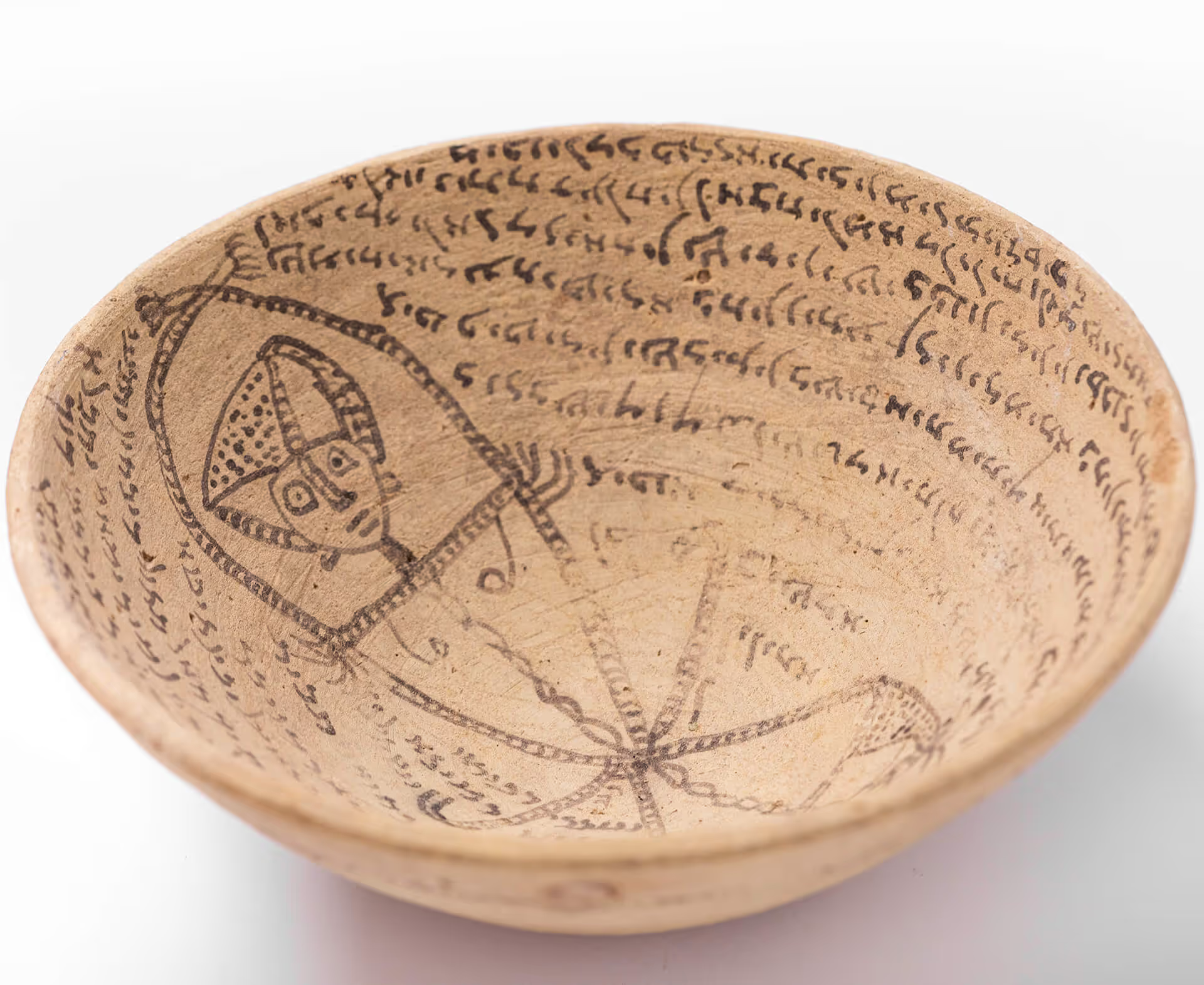

The Oldest Items in Our Collections: Demon-Busting Bowls From Babylon
Babylon. The middle of the first millennium CE. An individual gets up in the morning, suffering from a stomach ache or any other ailment that prevents one from leaving home and “earning one’s bread.” So, what does one do? At the time, in Babylon, there were several options: one could consult with the elders, visit the nearest doctor, pray to the heavens above or… order a magical bowl to capture the demons trapped inside oneself.
Incantation bowls are a sort of amulet. These clay bowls were covered with written blessings, curses and magical formulas, as well as illustrations. The bowls were often buried under the floor of a house to protect the owners, family and property from attacks by malicious demons. Between the fifth and eighth centuries CE, Babylon was flooded with these enchanted bowls used for capturing demons.
The Jews of Babylon were not the only ones who created and purchased magical exorcism bowls, but there is archaeological evidence to suggest that Jews were considered experts in the field. Over sixty percent of the bowls that have been found to date had their spells inscribed upon them by Jewish “magicians”, for the use of both Jews and non-Jews alike. Each bowl was made by hand and no two bowls were identical, though some of the same patterns and formulas do appear on many of them. Most of the bowls were made specially by pre-order for specific owners, whose names were inscribed on the bowls themselves.

Babylon. The middle of the first millennium CE. An individual gets up in the morning, suffering from a stomach ache or any other ailment that prevents one from leaving home and “earning one’s bread.” So, what does one do? At the time, in Babylon, there were several options: one could consult with the elders, visit the nearest doctor, pray to the heavens above or… order a magical bowl to capture the demons trapped inside oneself.
Incantation bowls are a sort of amulet. These clay bowls were covered with written blessings, curses and magical formulas, as well as illustrations. The bowls were often buried under the floor of a house to protect the owners, family and property from attacks by malicious demons. Between the fifth and eighth centuries CE, Babylon was flooded with these enchanted bowls used for capturing demons.
The Jews of Babylon were not the only ones who created and purchased magical exorcism bowls, but there is archaeological evidence to suggest that Jews were considered experts in the field. Over sixty percent of the bowls that have been found to date had their spells inscribed upon them by Jewish “magicians”, for the use of both Jews and non-Jews alike. Each bowl was made by hand and no two bowls were identical, though some of the same patterns and formulas do appear on many of them. Most of the bowls were made specially by pre-order for specific owners, whose names were inscribed on the bowls themselves.

Babylon. The middle of the first millennium CE. An individual gets up in the morning, suffering from a stomach ache or any other ailment that prevents one from leaving home and “earning one’s bread.” So, what does one do? At the time, in Babylon, there were several options: one could consult with the elders, visit the nearest doctor, pray to the heavens above or… order a magical bowl to capture the demons trapped inside oneself.
Incantation bowls are a sort of amulet. These clay bowls were covered with written blessings, curses and magical formulas, as well as illustrations. The bowls were often buried under the floor of a house to protect the owners, family and property from attacks by malicious demons. Between the fifth and eighth centuries CE, Babylon was flooded with these enchanted bowls used for capturing demons.
The Jews of Babylon were not the only ones who created and purchased magical exorcism bowls, but there is archaeological evidence to suggest that Jews were considered experts in the field. Over sixty percent of the bowls that have been found to date had their spells inscribed upon them by Jewish “magicians”, for the use of both Jews and non-Jews alike. Each bowl was made by hand and no two bowls were identical, though some of the same patterns and formulas do appear on many of them. Most of the bowls were made specially by pre-order for specific owners, whose names were inscribed on the bowls themselves.



Incantations were written on the bowls in three ancient Aramaic dialects – Jewish Babylonian Aramaic, Mandaic and Syriac. The text was usually inscribed on the inside of the bowl in spiral form, from the center outwards. Sometimes drawings were added to illustrate the efficacy of the magic, such as an image of a bound demon, a magician or some other heroic figure wrangling the evil demons. Today, we know of more than two thousand such magical bowls located in museums and private collections around the world. Most of them are preserved away from the public eye.
Recently, 216 of these rare magical bowls were donated to the Library from the private collection of the late Shlomo Moussaieff. These are among the oldest items in the Library's collections.
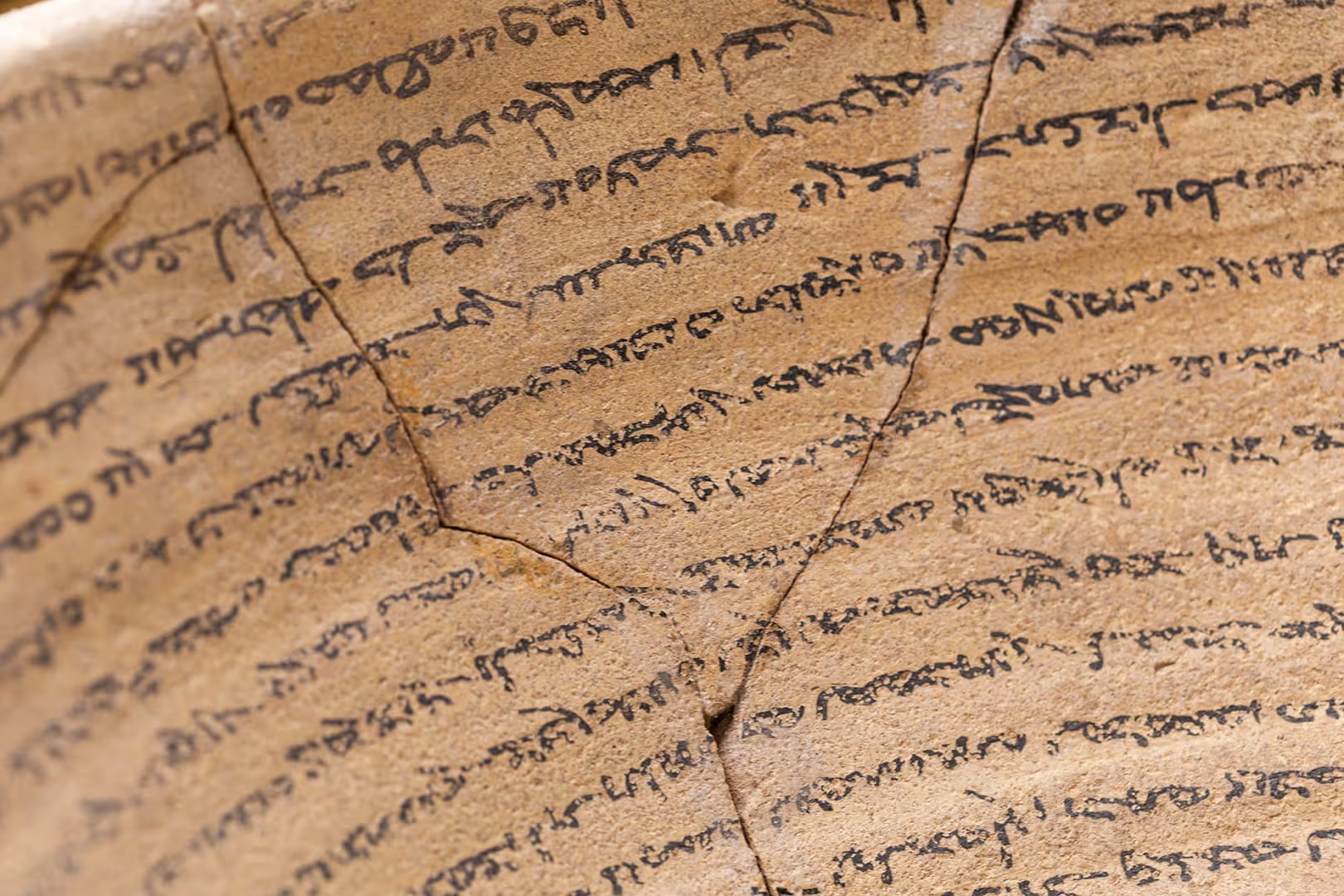
Incantations were written on the bowls in three ancient Aramaic dialects – Jewish Babylonian Aramaic, Mandaic and Syriac. The text was usually inscribed on the inside of the bowl in spiral form, from the center outwards. Sometimes drawings were added to illustrate the efficacy of the magic, such as an image of a bound demon, a magician or some other heroic figure wrangling the evil demons. Today, we know of more than two thousand such magical bowls located in museums and private collections around the world. Most of them are preserved away from the public eye.
Recently, 216 of these rare magical bowls were donated to the Library from the private collection of the late Shlomo Moussaieff. These are among the oldest items in the Library's collections.

Incantations were written on the bowls in three ancient Aramaic dialects – Jewish Babylonian Aramaic, Mandaic and Syriac. The text was usually inscribed on the inside of the bowl in spiral form, from the center outwards. Sometimes drawings were added to illustrate the efficacy of the magic, such as an image of a bound demon, a magician or some other heroic figure wrangling the evil demons. Today, we know of more than two thousand such magical bowls located in museums and private collections around the world. Most of them are preserved away from the public eye.
Recently, 216 of these rare magical bowls were donated to the Library from the private collection of the late Shlomo Moussaieff. These are among the oldest items in the Library's collections.



One of the bowls in the Library's collection was donated by Gershom Scholem, the famous scholar of Jewish mysticism. The inscription on this bowl tells the story of a character named Smumit, who lost her sons at the hands of a demon called Sydrus. She fled and built herself a fortress, where she gave birth to another son. Unfortunately, Sydrus managed to enter the fortress and kill this newborn child as well. When Sydrus’ crime was discovered, he fled. At this point, came a heavenly intervention: Four angels – Soni, Sasoni, Sangri, and Ertico – pursued and caught the demon. When they were about to kill him, he swore not to harm the children of the bowl owner wherever the names of the four angels were mentioned. The names of the first three angels can still be found today, in a slightly altered from, in amulets and talismans intended to protect pregnant women. The story of this bowl was originally published in 1985 by Joseph Naveh and Shaul Shaked. It was brought to light again more recently in the work of James Nathan Ford.

One of the bowls in the Library's collection was donated by Gershom Scholem, the famous scholar of Jewish mysticism. The inscription on this bowl tells the story of a character named Smumit, who lost her sons at the hands of a demon called Sydrus. She fled and built herself a fortress, where she gave birth to another son. Unfortunately, Sydrus managed to enter the fortress and kill this newborn child as well. When Sydrus’ crime was discovered, he fled. At this point, came a heavenly intervention: Four angels – Soni, Sasoni, Sangri, and Ertico – pursued and caught the demon. When they were about to kill him, he swore not to harm the children of the bowl owner wherever the names of the four angels were mentioned. The names of the first three angels can still be found today, in a slightly altered from, in amulets and talismans intended to protect pregnant women. The story of this bowl was originally published in 1985 by Joseph Naveh and Shaul Shaked. It was brought to light again more recently in the work of James Nathan Ford.



One of the bowls in the Library's collection was donated by Gershom Scholem, the famous scholar of Jewish mysticism. The inscription on this bowl tells the story of a character named Smumit, who lost her sons at the hands of a demon called Sydrus. She fled and built herself a fortress, where she gave birth to another son. Unfortunately, Sydrus managed to enter the fortress and kill this newborn child as well. When Sydrus’ crime was discovered, he fled. At this point, came a heavenly intervention: Four angels – Soni, Sasoni, Sangri, and Ertico – pursued and caught the demon. When they were about to kill him, he swore not to harm the children of the bowl owner wherever the names of the four angels were mentioned. The names of the first three angels can still be found today, in a slightly altered from, in amulets and talismans intended to protect pregnant women. The story of this bowl was originally published in 1985 by Joseph Naveh and Shaul Shaked. It was brought to light again more recently in the work of James Nathan Ford.

tab1img1=An incantation bowl. Most of the bowls that have been found were created by Jews.
tab2img1=Spells inscribed on an incantation bowl. They were usually inscribed on the inside of the bowl in spiral form, from the center outwards.
tab3img2=Bowl with a Jewish Babylonian Aramaic inscription. From the Gershom Scholem Collection at the National Library of Israel





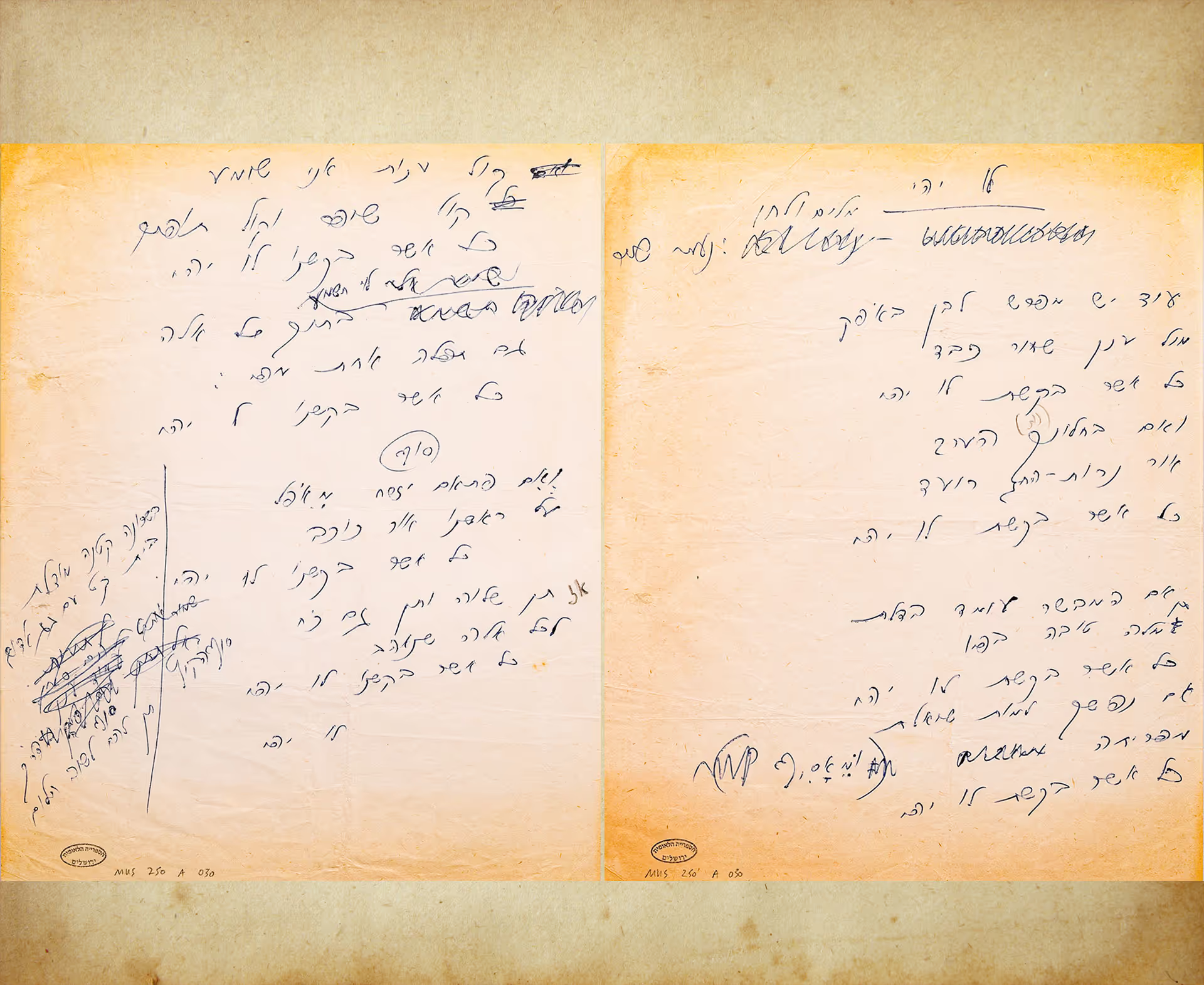
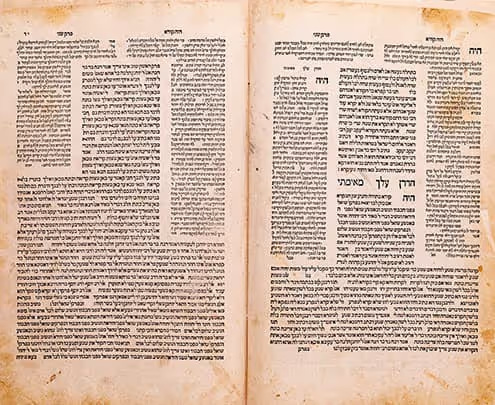





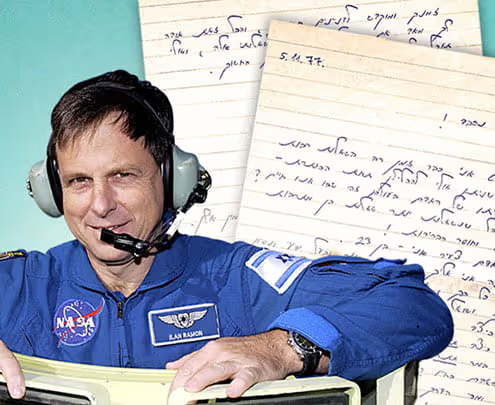

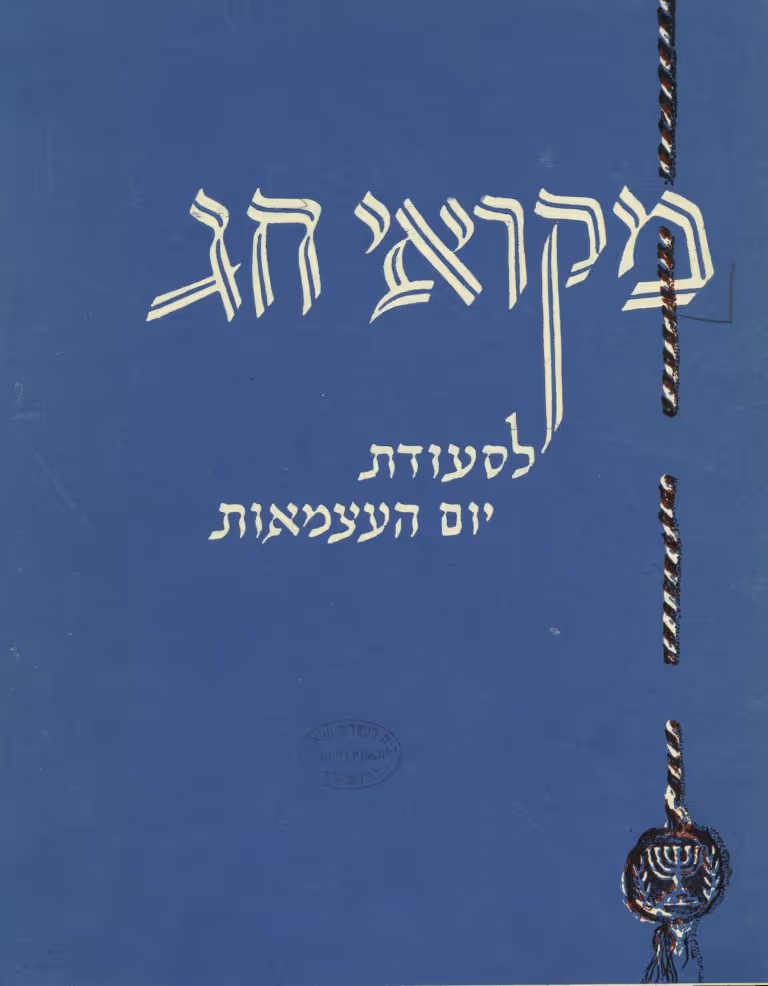
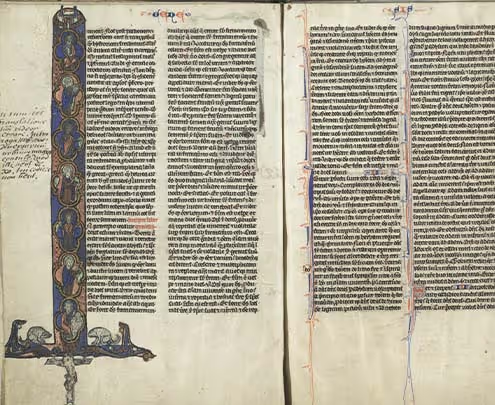

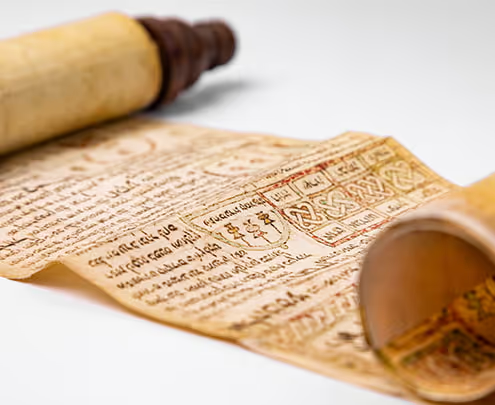


.avif)
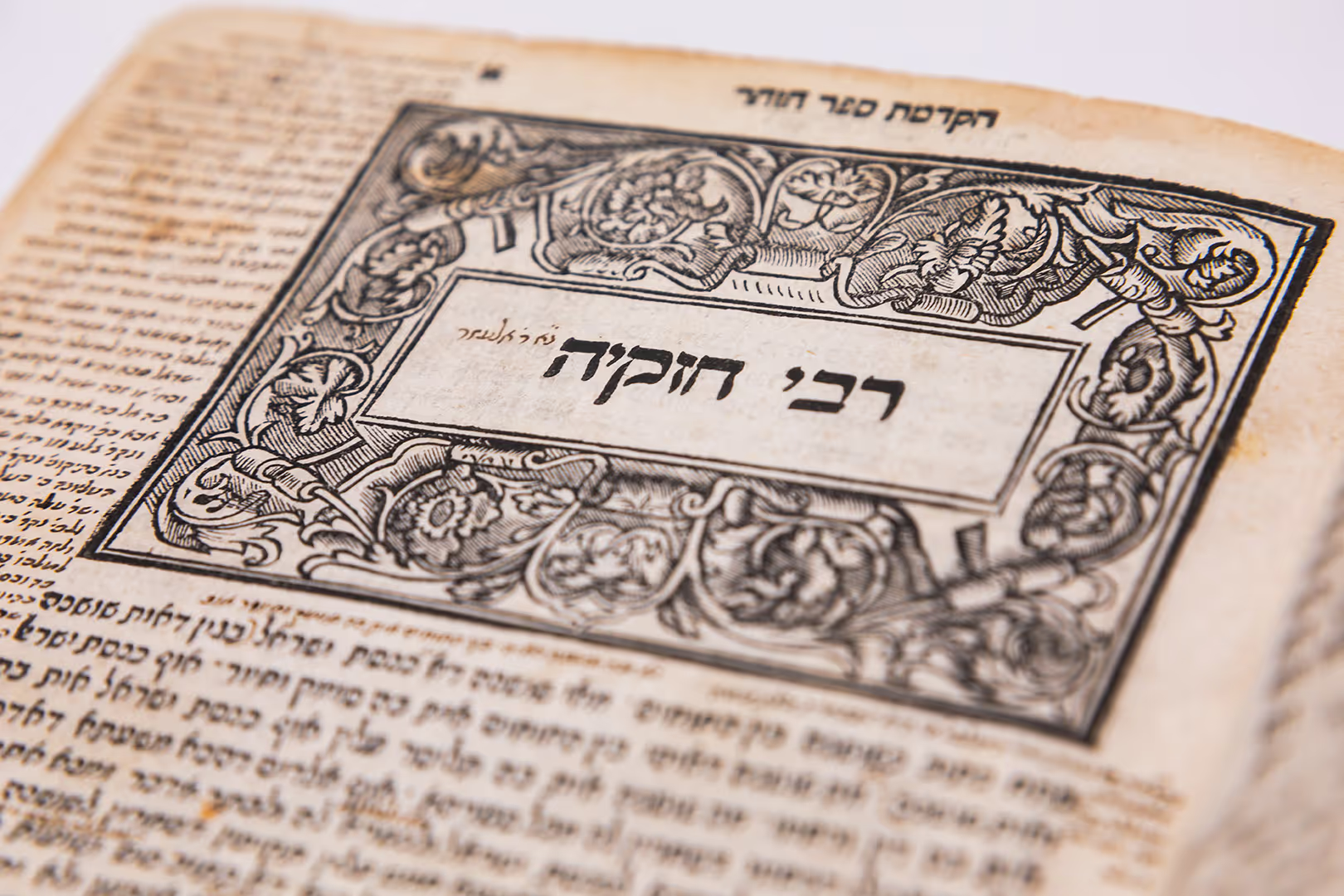





.svg)





